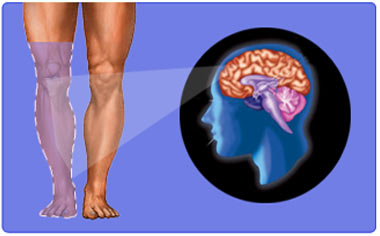Dr. Abhimanyu Rana

Phantom limb pain
Phantom limb pain is a perplexing and often distressing phenomenon that occurs when an individual feels pain or other sensations in a limb that no longer exists. This intriguing condition is commonly experienced by individuals who have undergone amputation, where the brain continues to perceive sensations from the missing limb. Phantom limb pain can range from mild discomfort to severe and debilitating pain, significantly impacting a person's quality of life and emotional well-being.
The exact mechanisms underlying phantom limb pain are not fully understood, but several theories have been proposed. One prevalent theory suggests that the brain's representation of the missing limb, known as the "body schema," remains intact even after amputation. This leads to confusion in the brain, causing it to interpret signals from the residual nerves as sensations and pain coming from the missing limb.
Phantom limb pain varies widely among individuals. Some people experience sensations like tingling, itching, or warmth, while others endure intense burning, stabbing, or throbbing pain. These sensations can be triggered by factors such as changes in weather, touching the residual limb, or even emotional stress. The pain can occur in both upper and lower limbs and may be continuous or intermittent.
Diagnosing and treating phantom limb pain requires a multidisciplinary approach involving healthcare professionals from various specialties. Physicians, pain specialists, and psychologists collaborate to address both the physical and psychological aspects of the condition. The diagnosis is typically based on the individual's description of the sensations, along with physical examinations and imaging studies to rule out other potential causes.
Management of phantom limb pain is challenging due to its complex nature. Treatment approaches aim to alleviate pain and improve the individual's overall well-being. Medications, such as analgesics, anticonvulsants, and antidepressants, may be prescribed to target nerve-related pain signals and modulate brain responses. Neuromodulation techniques like transcutaneous electrical nerve stimulation (TENS) and mirror therapy have also shown promise in providing relief by retraining the brain's perception of the missing limb.
Psychological interventions, particularly cognitive-behavioral therapy (CBT), can play a significant role in managing phantom limb pain. CBT helps individuals develop coping strategies, manage stress, and modify negative thought patterns that may exacerbate the pain. Relaxation techniques, mindfulness meditation, and biofeedback can also be incorporated into treatment plans to help individuals better control their pain perception.
In some cases, sensory feedback techniques are used to provide sensory input to the residual limb or even to a prosthetic limb. This may help alleviate phantom limb pain by reestablishing neural pathways and providing the brain with sensory information that aligns with its body schema.
Support groups and peer counseling can offer comfort and understanding to individuals experiencing phantom limb pain. Connecting with others who share similar experiences can provide validation, emotional relief, and practical advice for managing the challenges associated with this condition.
Research into the mechanisms of phantom limb pain and advancements in neuroscientific understanding are paving the way for more targeted and effective treatments. While complete eradication of phantom limb pain can be challenging, many individuals find relief through a combination of medical interventions, psychological support, and adaptive strategies.
In conclusion, phantom limb pain is a complex condition that defies easy explanation and treatment. It arises from the brain's persistent perception of sensations from a missing limb and can significantly impact an individual's physical and emotional well-being. Multidisciplinary approaches, including medical interventions, psychological therapies, and support networks, play a crucial role in managing phantom limb pain and improving the quality of life for those affected. Ongoing research offers hope for improved understanding and more effective treatment options in the future.

